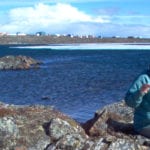A re-examination of Pleistocene fossils from southern Alberta has turned up some tantalizing evidence that the area may once have been home to a wider variety of big cats than previously thought, from sabretooths to Eurasian cave lions.
In the late 1960s, scientists from the Royal Ontario Museum and Geological Survey of Canada gathered more than 1,400 fossils from several locations near Medicine Hat. Among the ancient horses, camels, and bison, two bone fragments—one from a front leg, the other from a front foot—suggested the presence of previously unreported big cat species.
“Cats are large, charismatic apex predators that have a huge effect on the world around them,” said Ashley Reynolds, lead author of a new paper in the Canadian Journal of Earth Sciences that describes the fossils. “Understanding how they lived can tell us a lot.”
During the Pleistocene, between about 2.6 million and 12,000 years ago, much of North America was covered by two glaciers, the Laurentide Ice Sheet to the east and the Cordilleran Ice Sheet to the west. At some times they ran together, but at others an ice-free corridor opened up in what is now Alberta, connecting the Great Plains to the south with the temperate oasis of Beringia (now Alaska and the Yukon) to the north.
Previous finds have established that North America was, at various times, home to several large cats, including the American lion, about 25% bigger than the modern lion, and Smilodon, better known as the sabretooth. By contrast, Beringia, which was connected by a land bridge to what is now Russia, hosted the smaller, cold-adapted Eurasian cave lion.
So what happened when the barrier keeping these two worlds apart disappeared? Did the northern species move south, or did the southern ones move north?
The answer it seems, is both. In the paper, Reynolds and her co-authors attribute the foot bone to Smilodon, extending its known range to the north by about 1,000 km. But the front leg bone, or ulna, was trickier. It seemed too small to be an American Lion, but too large to be a smaller cat, such as a cougar or jaguar.
“I looked at it a lot and got very confused by it multiple times,” said Reynolds. “I kept asking ‘What are you?!”

Lead author Ashley Reynolds holds the Smilodon fatalis metacarpal from Medicine Hat, AB. On the table are a S. fatalis skull and canine tooth from Peru | Danielle Dufault © Royal Ontario Museum




